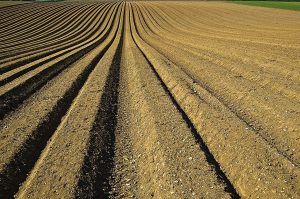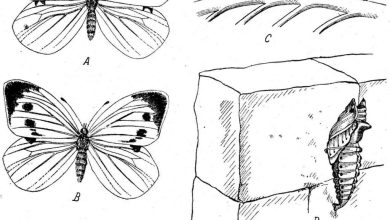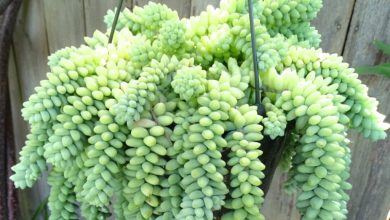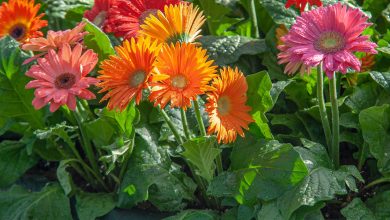How to Plant Chives in [13 Steps]: When, How and Where?

Did you know that in the Middle Ages chives were used asremedy for melancholyAnd to ward off evil spirits?Hence, today it is considered a medicinal herb.
Or… What do chives contain chemical substances that repel many insects from our garden or orchard and that act as a natural insecticide?
These are some reasons why you are interestedplant chives in your garden.
But not only this, look: Chives are easy to plant and are also resistant to cold and many pests.
What else do you need? Take a look at this guide and you will have few doubts to start growing your own chives and enjoy them in your kitchen!
What you need to know to Plant Chives
- When? Practically throughout the year. Avoid the hottest months.

- Where? Ideal in full sun.
- Harvest time? Approximately 8 weeks from sowing.
- How do we prepare the land? Eliminate weeds, we till and aerate. We put humus and a good supply of organic fertilizer.
- How do we water? Ideal, with drip.
- How often do we water? We avoid dumping. We try to keep the soil moist.
- How do we sow? Here to see the 12 steps.
- How do we harvest? When the plant has between four and eight pseudostems.
- Favorable associations? Carrots, celery, lettuce and tomatoes.
- Associations NOT favorable? Peas and beans.
- Plagues and diseases? Mildiu, Roya and white rot.
Hardy and fast-growing, chives are part of what are known as “French herbs”.
Its onion -like flavor, although milder and finer, makes it an ideal ingredient for use in dressings, vinegars, and soups.
It is a resistant plant that tolerates droughts, pests and frosts, so its cultivation is not too complicated.
It grows in clumps from bulbs and produces cupped leaves that are thinner than those of onions.
In addition, its appearance is highly decorative, so whether it is because you are growing your garden or because you want to decorate your garden, in this article we offer you some useful tips so that you can achieveplant chives successfully.
Main benefits of chives
Among the main benefits of chives we find that they strengthen nails and teeth, and contain antibiotic properties.
In addition, they stimulate appetite and regulate high blood pressure.
The following are some of the most important contributions:
- They are rich in vitamin A, B, C and K. In addition, they provide protein, fiber, calcium, magnesium, sodium, potassium and phosphorus.
- They are antiscorbutic, antitussive, diuretic, expectorant and laxative. Chives have been used in various experimental cancer treatments, yielding great results as a preventive of prostate, esophageal and stomach cancer.
- It is an effective ally against depression.
- It is insect repellant.
- It helps block the formation of clots and has a fibrillating action on blood vessels, thereby minimizing the risk of heart attacks.
- Clears nasal congestion.
- The allicin it contains is a powerful antibacterial agent, and can be used topically as a disinfectant and fungicide,
- Reduces flatulence.
- Prevents bad breath.
About the chives
The chive, Allium schoenoprasum , is a perennial plant with thin, pointed leaves approximately 60 cm long, and although it is yellow like the onion, it does not produce bulbs like the latter.
It is also known as leaf onion, Chinese onion, ciboulette, xonacatl, spring onion, chives or garlic chives.
It is thought that it originated in Siberia, and from there it spread to the extreme north of America.
There are different varieties, although all of them have cylindrical and hollow leaves with a flavor similar to onion, but not as intense.
Its flowers, also edible, are pink or white, and grow arranged in umbrellas.
It can be said that it is a perennial herb that is grown as an annual, so it is quite common to find it in home gardens where the plant is not uprooted but some of its leaves are cut to take advantage of.
In fact, in most countries only its leaves are sold, although in some parts of South America the whole plant is available.
It can be grown quite easily, either from seed or by dividing the bulbs and roots after extraction.
Some more common varieties are:
- Grolau: Swiss variety developed specifically for growing indoors and in greenhouses. Its leaves are very strong flavor, thick and dark.
- nelly: it has very fine-textured leaves, with a greenish- blue color.
- StaroPairing: It has very thick dark leaves, and a fairly pronounced flavor.
- Chinese chives (Allium tuberosum): It is also known as Chinese garlic. It is similar to garden chives, but its leaves are flat and its flowers are white. It is grown in the same way as the garden chive and makes an excellent ornamental plant. Its flavor is more similar to garlic than onion.
- French chives or chives: most common variety. Its flavor is affected if it spends a lot of time in the sun or in the shade.
What do we need to plant chives?
When to plant chives? The dates
can beplant chives by transplant practically all year round, although very hot months should be avoided, specifically the summer months.
The optimal planting time is from the beginning of spring to the end of autumn. It is important to note that not all varieties are winter hardy.
The less heat-resistant French variety chives should be sown in late summer.
Where to grow chives?
Chives thrive in full sun, but since they come from cool, cold climates, they have a high tolerance for frost.
However, it is recommended to plant it from spring in very cold areas.
Usually,it needs a lot of light and soft sun, it resists a few hours of shade.
Similarly, French chives do not respond very well to permanent sun, and although they are not affected too much, their flavor and aroma are intensified when grown mostly in the shade.
However, if you are planting chives for its aesthetic appearance, consider that in the shade it produces fewer flowers.
How do we water? Moisture and risks
To germinate, chives require regular watering to ensure the humidity of the substrate, although we must ensure thathumidity is not excessive, especially when the crop is close to harvest.
Therefore, moderate watering is required, not very abundant and frequent. As a reference, we should not let the soil dry completely.
Irrigation can be by furrow, sprinkler or drip, and even rain is favorable as long as it is not excessive and the soil has good drainage.
Substrate and nutrients: How do we prepare the soil?

Chives prefer moist soils, slightly clayey and very rich in nutrients, preferably calcareous humus for better drainage.
They grow best in soils with a high content of organic matter, so mulch or compost applications are recommended before cultivation to improve the structure and nutritional value of the soil.
In addition, it is beneficial to fertilize plants that are harvested frequently.
Chives need a soil pH of 6.0 to 7.0
They need a good supply of nitrogen in the soil, so it is advisable to plant chives in gardens where beans or peas have been planted before.
For organic fertilizers, a mixture of 50% earth, 30% compost, 10% earthworm humus and 10% perlite is recommended.
For non-organic fertilizers, you can use a balanced fertilizer in a 1:1:1 proportion of nitrogen, phosphorus and potassium, even fertilized with manure.
How to Plant Chives [13 steps]
Step 1: Clear the ground
 It removes weeds and remains of previous crops and all kinds of residues to ensure that the chives receive the correct amount of nutrients.
It removes weeds and remains of previous crops and all kinds of residues to ensure that the chives receive the correct amount of nutrients.
All plants must be pulled out by the roots to prevent them from growing back.
Step 2: Moisten the soil before planting chives
This reduces the risk of expelling the seeds by the force of the water.
Step 3: Fertilize the soil
Spread some compost, vermiculite, or perlite to improve the overall quality before you start the chives. Mix them into the soil to a depth of 5 centimeters.
Step 4: Make furrows in the dirt
 with a distance of 40 centimeters between one and the other. Then dig holes in each row, making sure to leave a distance of 10 cm between them.
with a distance of 40 centimeters between one and the other. Then dig holes in each row, making sure to leave a distance of 10 cm between them.
Step 5: Put 2 to 3 chive seeds in each hole
to a maximum depth of 1 cm. Cover them lightly.
Step 6: Select the healthiest and strongest seedlings
The seeds take up to a couple of weeks to germinate. If more than one seed has germinated in each hole, keep the strongest one.
To do this, do not pull the weak one, as you can damage the leaves. A simple pruning at ground level is sufficient.
Step 7: Add compost once the seedlings sprout
Covering the soil with compost will prevent weeds from growing around your plants that can steal nutrients.
Step 8: Transplant your shoots
 If you have planted in a pot or seedbed, you should transplant approximately six weeks after planting. Choose moderate sun and well-ventilated garden.
If you have planted in a pot or seedbed, you should transplant approximately six weeks after planting. Choose moderate sun and well-ventilated garden.
Leave between 5 and 10 centimeters between each of your plants.
Step 9: Water Regularly
The chive plant should be watered when the soil is dry and weeds should be removed regularly, as these can affect healthy ones.To find out when it is convenient to water, bury a pencil in the soil.
If it comes out dry it means that the soil needs to be watered. On the contrary, if it comes out with traces of soil attached, it means that the soil still contains enough moisture in the lower layers.
Wait until the top 3 inches of soil has dried out before watering it again.
Step 10: Fertilize regularly
If you fertilized the soil before planting the chives, you’ll need to do it again if you plan to harvest them often.
Step 11: Prune your plants regularly
Chives grow very easily and very quickly as they can self-seed. To prevent it from invading your entire garden, you have to prune the flowers before they wither.
To keep the plants vigorous it is suggested to divide them every 2 to 3 years.
The harvest and harvesting of chives
 Chives planted during the spring seasons lastapproximately eight weeks to mature.
Chives planted during the spring seasons lastapproximately eight weeks to mature.
If they are planted in winter, their development takes a little longer, between 30 and 40 weeks.
It is recommended to harvest chives when the plant has between four and eight pseudostems.
Harvest chives throughout the season to prevent leaves from hardening and to encourage new bulb development.
Cut the leaves trying to leave 3 to 5 cm from the base. The leaves can be harvested when desired, when they exceed approximately 15 centimeters.
You can harvest it anytime you need it. You can consume it fresh, but you can also store it dry or frozen.
The collection of flowers, to be used in salads, is done when the flower opens. Flowering usually occurs between May and June.
favorable associations
A very favorable association for chives is carrot.
Not only does chives improve the growth and flavor of carrots, but growing carrots helps control pests.
It goes well with celery, lettuce and tomatoes.
It is also advisable to plant the chives in the vicinity of the parsley, since it has the particularity of keeping the fly away from the plant.
Associations NOT favorable
It is not recommended to plant it together with peas and beans (after this one, yes).
The most common pests and diseases
It is a very resistant plant that is rarely attacked by pests or diseases.
In addition, it has the peculiarity of keeping aphids and root flies away.
However, it is prone to certain diseases and pests, such as onion fly, white rot, and mildew.
One way to treat onion fly infestation is to plant chives near carrots.
Mildew
To combat it, it is recommended to eliminate weeds and crop residues, as well as to avoid excess humidity by promoting adequate ventilation of the plant.
Affected leaves should be removed. Horsetail extract can also be applied.
Rust
It attacks the aerial part of the plant, mainly the leaves and stems, where powdery masses with a rusty appearance appear.
The recommended treatment is based on fungicides.
white rot
It is prevented by improving plant ventilation.



![Photo of Hanging Plants: [Planting, Care, Examples, Irrigation and Images]](https://www.complete-gardening.com/wp-content/uploads/2022/08/2_Lobelia-300x225-1-300x220.jpg)
